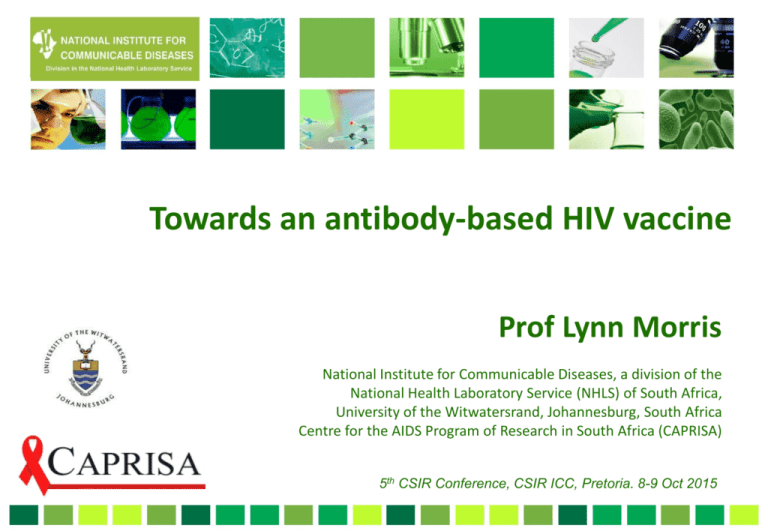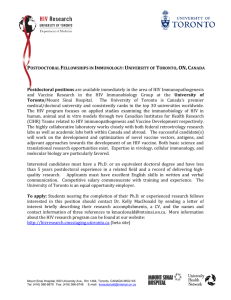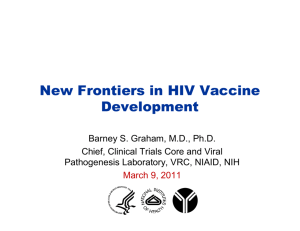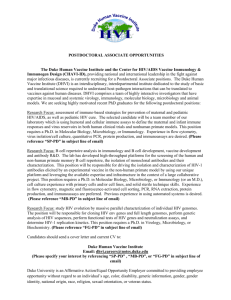Click here to presentation
advertisement

Towards an antibody-based HIV vaccine Prof Lynn Morris National Institute for Communicable Diseases, a division of the National Health Laboratory Service (NHLS) of South Africa, University of the Witwatersrand, Johannesburg, South Africa Centre for the AIDS Program of Research in South Africa (CAPRISA) 5th CSIR Conference, CSIR ICC, Pretoria. 8-9 Oct 2015 Overview • Vaccination as a public health intervention • HIV vaccine trials and immune correlates • Roadblocks and roadmaps for inducing broadly neutralizing antibodies • The promise of passive immunization Apart from the provision of clean water, vaccines have had a more profound effect on world health, especially of children, than any other public health measure. E Richard Moxon, University of Oxford, UK Most licensed vaccines work by inducing neutralizing antibodies that fight virus infections The Global HIV Pandemic ~5,500 new HIV infections every day ~4,000 AIDS deaths every day HIV prevalence in young pregnant women in rural Vulindlela, South Africa (2009-2012) Age Group (Years) HIV Prevalence (N=1029) ≤16 8.4 17-18 18.6 19-20 25.4 21-22 32.8 23-24 44.8 Quarraisha and Salim Abdool Karim Why don’t we have a vaccine against HIV? • • • • No-one has ever recovered from HIV infection HIV is a rapidly moving target HIV integrates into human DNA It is difficult to neutralize HIV (complex surface envelope glycoprotein) • Current vaccines are unable to stimulate broadly neutralizing antibodies HIV Vaccine Efficacy Trials To Date No NOTE: Phambili (HVTN 503) began to explore a regimen similar to STEP in South Africa (not included) Non-neutralizing antibodies to V1V2 correlated with protection in the RV144 vaccine trial A 10000 B Probability of Infection 0.010 MFI 1000 100 10 Placebo Low Medium High 0.008 0.006 0.004 0.002 0.000 0 0 Uninfected Placebo Low Medium High Uninfected Vaccine 12 24 36 Time since Week 26 visit (months) Haynes et al., 2012 Formation of the P5 Partnership in 2010 (Pox-Protein Public Private Partnership) Purpose: To build on RV144 data and ultimately license a poxprotein based HIV vaccine with the potential for broad and timely public health impact. Strategy: Continue to build public-private partnerships critical for success. 1.Work with host countries to support a flexible regulatory strategy in target populations and regions. 2.Generate and incorporate knowledge from the assessment of nextgeneration vaccine concepts. Timeline for P5 Efficacy Trial 12 Reasons for Optimism • Vaccination can alter risk of acquiring HIV infection • Protection correlated with non-neutralizing V1V2 antibodies that are relatively easy to induce • However, better vaccine efficacy will likely require the induction of neutralizing antibodies • Recent structure of HIV envelope trimer has resulted in better immunogens • A large number of potent and broadly neutralizing monoclonal antibodies have been isolated from HIV infected individuals Understanding how broadly neutralizing antibodies develop in HIV infection Breadth Years of Infection UCA (Unmutated common ancestor ) Viral mechanisms for stimulating bNAbs Moore, Williamson and Morris, Trends in Microbiology 2015 Viral diversity Creation of bNAb epitopes through viral escape Exposure of bNAb epitopes through viral escape Strain-specific antibodies Broadly neutralizing antibodies Generation of epitope variants (immunotypes) through viral escape Moore et al., Nat Med 2012; Liao et al., Nature 2013; Wibmer et al., PLoS Path 2013; Gao et al., Cell 2014; Doria-Rose et al., Nature 2014; Bhiman et al., Nat Med in press Escape from autologous antibodies creates a V3/glycan bNAb epitope Viral escape through glycan shielding +332 glycan Infecting virus Breadth Years of Infection Penny Moore et al., Nature Medicine, 2012 bNAbs are able to tolerate multiple immunotypes (toggling escape mutations) 169K Epitope variants (immunotypes) through viral escape 169I 169R 169Q Breadth Years of Infection Jinal Bhiman et al., Nature Medicine, in press Sequential immunization strategies Breadth Years of Infection Malherbe et al, 2011; Haynes et al., 2012; Moore et al, 2012; Liao et al, 2013 HIV-1 bNAbs display unusual properties that present significant challenges for vaccine development .. .. V1V2/glycan Long CDRH3 (>25 aa) CD4bs Heavily mutated (up to 30%) Modified from Burton et al., Science 2012 CD4 binding site antibodies develop through a process of extensive somatic hypermutation Nature 2013 CD4bs CH103 V1V2 antibodies with long CDRH3 regions are selected during the initial recombination event .. V1V2/glycan CAP256-VRC26 Nature 2014 .. Rapid development of neutralization breadth within the CAP256-VRC26 lineage UCA Ab % Neutralization CAP256-VRC26-UCA 100 80 60 CAP256-VRC26-I2 CAP256-VRC26.01 100 100 80 80 80 60 60 60 40 40 40 40 20 20 20 20 0 0.01 Mutations (nt) Heavy Light CAP256-VRC26-I1 100 0.1 1 mg/mL 0 0 10 100 0 0.01 SU 0.1 1 mg/mL 2.1% 1.1% 10 100 0 0.01 0.1 1 mg/mL 6.3% 2.1% 10 100 0 0.01 SU ZM53.12 ZM197 KER2018 KER2008 CM244 CAP210 30163v5.c45 0.1 1 10 100 mg/mL 8.3% 3.9% Doria-Rose, Schramm, Gorman, Moore et al., Nature 2014 Different routes to neutralization breadth Unmutated common Ancestor (UCA) MONTHS YEARS + + + + + CD4bs lineage Binding to autologous Env Strain-specific neutralization Broad neutralization + .. .. V1V2 lineage Binding to autologous Env Strain-specific neutralization Broad neutralization + + + + + Derdeyn, Moore and Morris. COHA 2014 Which pathway is more amenable to HIV vaccine design? .. .. V1V2 lineage CD4bs lineage Requires engagement with rare B cells with long CDRH3 which are often deleted No requirement for long CDRH3 but may need to engage particular germline alleles Once stimulated, V1V2 bNAbs can develop within months, not years Needs high levels of affinity maturation - which may be hard to achieve through vaccination Active versus Passive/Vector-based Immunoprophylaxis (VIP) Vaccination Stimulating an antibody response Passive “vaccination” Infusion with protective antibodies VIP Production of antibodies by vector Highly potent bNAbs are being tested as “drugs” to prevent HIV Passive Immunization – shortcut to an HIV vaccine? • Passive immunization tests the role of neutralizing antibodies in the absence of other vaccine immune responses • Such studies wont provide information on the immunological roadblocks to inducing bNAbs • Efficacy data for prevention of sexual transmission will not be available for a number of years • Prospects for using bNAbs for prevention at a population-level still need to be assessed The Promise of Passive Immunization • Provide proof-of-principle that bNAbs can prevent HIV infection in humans • Determine the minimal dose of antibody (including levels at mucosal surfaces) • Identify the best viral epitopes to target • Assess the importance of antibody isotypes • Provide additional correlates of protection CAP256-VRC26.25 mAb • Broadly neutralizing mAb isolated from CAPRISA donor, CAP256 • Targets the V1V2 region of the HIV-1 envelope, in particular the K169 residue which is more common in subtype C viruses • Unlike other members of this class, neutralization does not depend on binding to key glycans • Neutralises 72% of clade C panel (63% of all subtypes) and is exceptionally potent so may require less antibody to achieve inhibitory concentrations Breadth and potency of CAP256-VRC26 against HIV-1 clade C isolates 0.00001 IC50 (ug/ml) 0.0001 0.001 0.01 0.1 1 10 100 CAP256.08 CAP256.25 PGDM1400 PG9 CH01 PGT121 PGT151 VRC01 10E8 Doria-Rose et al., J Virology in press Development plan for CAP256-VRC26.25 for passive immunization • Manufacture GLP lot • Monkey challenge study • Sub-cutaneous formulation • GMP lot manufacture and formulation for human trials and stability studies • Pre-clinical studies • Regulatory filing of IND • Phase I/II safety & proof-of-concept trial (CAPRISA 012) CAP256-VRC26.25 IgG Prospects for an antibody-based HIV vaccine • An HIV vaccine is an achievable goal • RV144 has provided immune correlates that are being pursued in large scale efficacy trials • Studies in HIV infection have identified critical factors in bNAb induction; although significant challenges remain in translating these into an HIV vaccine • Passive immunization will provide proof-ofconcept for bNAb-mediated protection NICD HIV ANTIBODY GROUP Collaborators and Funders CAPRISA Salim Abdool Karim Quarraisha Abdool Karim Nigel Garrett Carolyn Williamson VRC John Mascola Peter Kwong Nicole Doria-Rose Jay Gorman Columbia Larry Shapiro Chaim Schramm Duke/CHAVI-ID Barton Haynes Tony Moody Larry Liao Georgia Tomaras David Montefiori HVTN Glenda Gray Larry Corey Julie McElrath John Hural




